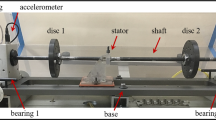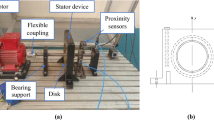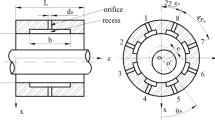Abstract
This paper is focused on the dynamic characteristics of a flexible rotor with squeeze film damper excited by two frequencies. The multiple harmonic balance method and Runge–Kutta method are combined to analyze the periodic solution and quasi-periodic solution of the system. The nonlinear characteristics discussed are fastened on the resonance region corresponding, respectively, to the rigid body translation mode and first bending mode. In the former region, the motion of disk center shows the ‘hard spring’ characteristic, and the combination frequencies are dominated by the difference between double low excitation frequency and high excitation frequency and the difference between double high excitation frequency and low excitation frequency. In the latter region, however, the combination frequencies are dominated by the difference between high excitation frequency and double low excitation frequency and the difference between triple low excitation frequency and double high excitation frequency. Moreover, the motion of disk center shows a kind of ‘cross’, ‘soft spring’ or ‘hard spring’ characteristics with the variation of the ratio of the two excitation frequencies. Besides, the independent quasi-periodic solution coexists with the periodic solution in these cases. The system is sensitive to the ratio of excitation frequencies, and it could have two independent quasi-periodic solutions in some conditions. The results in this paper provide a reveal of nonlinear characteristics in this type of double excitation nonlinear rotor system.















Similar content being viewed by others
References
Cooper, S.: Preliminary investigation of oil films for the control of vibration. In: Proceedings of the Lubrication and Wear Convention, pp. 305–315. Institution of Mechanical Engineers (1963)
Mohan, S., Hahn, E.J.: Design of squeeze film damper supports for rigid rotors. ASME J. Manuf. Sci. Eng. 96(3), 976–982 (1974)
Levesley, M.C., Holmes, R.: The efficient computation of the vibration response of an aero-engine rotor-damper assembly. Proc. Inst. Mech. Eng. Part G: J. Aerosp. Eng. 208(1), 41–51 (1994)
Taylor, D.L., Kumar, B.R.K.: Nonlinear response of short squeeze film dampers. ASME J. Tribol. 102(1), 51–58 (1980)
Gunter, E.J., Barrett, L.E., Allaire, P.E.: Design of nonlinear squeeze-film dampers for aircraft engines. ASME J. Tribol. 99(1), 57–64 (1977)
Zeidan, F., Vance, J.: Cavitation and air entrainment effects on the response of squeeze film supported rotors. ASME J. Tribol. 112(2), 347–353 (1990)
Nikolajsen, J.L., Holmes, R.: Investigation of squeeze-film isolators for the vibration control of a flexible rotor. Proc. Inst. Mech. Eng. Part C: J. Mech. Eng. Sci. 21(4), 247–252 (1979)
Holmes, R., Dogan, M.: Investigation of a rotor bearing assembly incorporating a squeeze-film damper bearing. Proc. Inst. Mech. Eng. Part C: J. Mech. Eng. Sci. 24(3), 129–137 (1982)
Sykes, J.E.H., Holmes, R.: The effects of bearing misalignment on the non-linear vibration of aero-engine rotor-damper assemblies. Proc. Inst. Mech. Eng. Part G: J. Aerosp. Eng. 204(2), 83–99 (1990)
Zhao, J.Y., Linnett, I.W., McLean, L.J.: Stability and bifurcation of unbalanced response of a squeeze film damped flexible rotor. ASME J. Tribol. 116(2), 361–368 (1994)
Zhao, J.Y., Linnett, I.W., McLean, L.J.: Subharmonic and quasi-periodic motions of an eccentric squeeze film damper-mounted rigid rotor. ASME J. Vib. Acoust. 116(3), 357–363 (1994)
Zhu, C.S., Robb, D.A., Ewins, D.J.: Analysis of the multiple-solution response of a flexible rotor supported on non-linear squeeze film dampers. J. Sound Vib. 252, 389–408 (2002)
Sundararajan, P., Noah, S.T.: Dynamics of forced nonlinear systems using shooting/arc-length continuation method–application to rotor systems[J]. ASME J. Vib. Acoust. 119(1), 9–20 (1997)
Inayat-Hussain, J.I., Kanki, H., Mureithi, N.W.: On the bifurcations of a rigid rotor response in squeeze-film dampers. J. Fluids Struct. 17, 433–459 (2003)
Inayat-Hussain, J.I., Kanki, H., Mureithi, N.W.: Chaos in the unbalance response of a rigid rotor in cavitated squeeze-film dampers without centering springs. Chaos Soliton Fract. 13(4), 929–945 (2002)
Bonello, P., Brennan, M.J., Holmes, R.: Non-linear modelling of rotor dynamic systems with squeeze film dampers—an efficient integrated approach. J. Sound Vib. 249(4), 743–773 (2002)
Chang-Jian, C.W., Kuo, J.K.: Bifurcation and chaos for porous squeeze film damper mounted rotor-bearing system lubricated with micropolar fluid. Nonlinear Dyn. 58(4), 697–714 (2009)
Boyaci, A., Lu, D., Schweizer, B.: Stability and bifurcation phenomena of Laval/Jeffcott rotors in semi-floating ring bearings. Nonlinear Dyn. 79(2), 1535–1561 (2015)
Schweizer, B.: Oil whirl, oil whip and whirl/whip synchronization occurring in rotor systems with full-floating ring bearings. Nonlinear Dyn. 57(4), 509–532 (2009)
Zhou, H.L., Luo, G.H., Chen, G., et al.: Analysis of the nonlinear dynamic response of a rotor supported on ball bearings with floating-ring squeeze film dampers. Mech. Mach. Theory 59, 65–77 (2013)
Hai, P.M., Bonello, P.: An impulsive receptance technique for the time domain computation of the vibration of a whole aero-engine model with nonlinear bearings. J. Sound Vib. 318(3), 592–605 (2008)
Bonello, P., Hai, P.M.: Computational studies of the unbalance response of a whole aero-engine model with squeeze-film bearings. ASME J. Eng. Gas Turbines Power 132(3), 032504 (2010)
Bonello, P., Pham, H.M.: A theoretical and experimental investigation of the dynamic response of a squeeze-film damped twin-shaft test rig. Proc. Inst. Mech. Eng. Part C: J. Mech. Eng. Sci. 228(2), 218–229 (2014)
Booker, J.F.: A table of the journal bearing integral. ASME J. Basic Eng. 87(2), 533–535 (1965)
Kim, Y.B., Choi, S.K.: A multiple harmonic balance method for the internal resonant vibration of a non-linear Jeffcott rotor. J. Sound Vib. 208(5), 745–761 (1997)
Zhang, Z.Z., Chen, Y.S., Cao, Q.J.: Bifurcations and hysteresis of varying compliance vibrations in the primary parametric resonance for a ball bearing. J. Sound Vib. 350, 171–184 (2015)
Hsu, C.S.: On approximating a general linear periodic system. J. Math. Anal. Appl. 45(1), 234–251 (1974)
McLean, L.J., Hahn, E.J.: Stability of squeeze film damped multi-mass flexible rotor bearing systems. ASME J. Tribol. 107(3), 402–409 (1985)
Inayat-Hussain, J.I.: Bifurcations in the response of a flexible rotor in squeeze-film dampers with retainer springs. Chaos Soliton Fract. 39(2), 519–532 (2009)
Acknowledgements
The authors would like to acknowledge the financial supports from the National Basic Research Program (973 Program) of China (Grant No. 2015CB057400), the National Natural Science Foundation of China (Grant No. 11602070) and China Postdoctoral Science Foundation (Grant No. 2016M590277).
Author information
Authors and Affiliations
Corresponding author
Appendices
Appendix 1: List of symbols
- \(a_{j,k ,l} , b_{j,k,l}\) :
-
Harmonic coefficients of dimensionless displacements, dimensionless
- A :
-
Periodic matrix, dimensionless
- B :
-
Dimensionless bearing parameter of squeeze film damper, dimensionless
- c :
-
Clearance of squeeze film damper, m
- \(c_{j,k,l} ,d_{j,k,l}\) :
-
Harmonic coefficients of dimensionless nonlinear forces, dimensionless
- \(c_{1}\) :
-
Damping coefficient corresponding to transverse deformation of the shaft, N s/m
- \(c_{2}\), \(c_{3}\) :
-
Damping coefficients corresponding to coupling deformation of the shaft, N s
- \(c_{4 }\) :
-
Damping coefficient corresponding to angular deformation of the shaft, N m s
- \(c_{5}\), \(c_{6}\) :
-
Damping coefficients of the supports, N s/m
- D :
-
Monodromy matrix, dimensionless
- \(F_{\mathrm{cx}}\), \( F_{\mathrm{cy}}\) :
-
Oil film forces in the Cartesian coordinate system, N
- \(\bar{{F}}_{\mathrm{cx}} ,\bar{{F}}_{\mathrm{cy}} \) :
-
Dimensionless oil film forces in the Cartesian coordinate system, dimensionless
- \(F_{\mathrm{r}}\), \(F_{{\uptau } }\) :
-
Oil film forces in the polar coordinate system, N
- \(\bar{{F}}_{\mathrm{r}} ,\bar{{F}}_{{{\uptau } }} \) :
-
Dimensionless oil film forces in the polar coordinate system, dimensionless
- G :
-
Vector of harmonic balance terms, dimensionless
- J :
-
Jacobi matrix, dimensionless
- \(J_{\mathrm{d}}\) :
-
Equivalent equatorial moment of inertia of the disk, kg \(\hbox {m}^{2}\)
- \(J_{\mathrm{p}}\) :
-
Equivalent polar moment of inertia of the disk, kg \(\hbox {m}^{2}\)
- k, l :
-
Harmonic parameters, dimensionless
- \(k_{\mathrm{rr}}\) :
-
Stiffness coefficient corresponding to transverse deformation of the shaft, N/m
- \(k_{\mathrm{r}{\upvarphi }}\), \(k_{{\upvarphi } \mathrm{r}}\) :
-
Stiffness coefficients corresponding to coupling deformation of the shaft, N
- \(k_{{\upvarphi } {\upvarphi } }\) :
-
Stiffness coefficient corresponding to angular deformation of the shaft, N m
- \(k_{\mathrm{a}}\), \(k_{\mathrm{b}}\) :
-
Stiffness coefficient of the supports, N/m
- l :
-
Length of the shaft, m
- \(l_{1}\) :
-
Distance from the disk to the left support, m
- \(l_{2}\) :
-
Distance from the disk to the right support, m
- \(l_{3}\) :
-
Distance from the disk to the intershaft bearing, m
- L :
-
Length of squeeze film damper, m
- m, n :
-
Parameters of discrete points in time domain, dimensionless
- \(m_{\mathrm{o}}\) :
-
Equivalent mass of the rotor, kg
- \(m_{\mathrm{a}}\) :
-
Equivalent mass of the left journal, kg
- \(m_{\mathrm{b}}\) :
-
Equivalent mass of the right journal, kg
- M :
-
Maximal harmonic parameter, dimensionless
- N :
-
Number of discrete points in time domain, dimensionless
- P :
-
Vector of harmonic coefficients of dimensionless displacements, dimensionless
- \(q_{\mathrm{j}}\) :
-
Dimensionless displacement (j=1\(\sim \)8), dimensionless
- Q :
-
Vector of harmonic coefficients of dimensionless nonlinear forces, dimensionless
- r :
-
Radial displacement of journal, m
- R :
-
Radius of the journal, m
- s :
-
Dimensionless arc length, dimensionless
- t :
-
Time, s
- U :
-
Vector of state variables, dimensionless
- \(U_{1}\), \(U_{2}\), \(U_{3}\) :
-
Dimensionless unbalance value, dimensionless
- x, y :
-
Displacements of center of disk, m
- \(x_{\mathrm{a}}\), \(y_{\mathrm{a}}\) :
-
Displacements of center of left journal, m
- \(x_{\mathrm{b}}\), \(y_{\mathrm{b}}\) :
-
Displacements of center of right journal, m
- \(\alpha _{0}\), \(\alpha _{1}\), \(\alpha _{2}\) :
-
Dimensionless mass, dimensionless
- \(\gamma _{1}\), \(\gamma _{2}\) :
-
Ratio of distance \( l_{1}\), \(l_{2}\) to length l, dimensionless
- \(\delta _{1}\), \(\delta _{2}\) :
-
Unbalance value, kg m
- \(\varepsilon \) :
-
Dimensionless radial displacement of journal, dimensionless
- \(\zeta _{\mathrm{j}}\) :
-
Dimensionless damping coefficients (j=1\(\sim \)6), dimensionless
- \(\eta \) :
-
Ratio of moment of inertia \(J_{\mathrm{p}}\) to moment of inertia \( J_{\mathrm{d}}\), dimensionless
- \(\theta \) :
-
Journal position angle measured from line of journal centers, dimensionless
- \(\theta _{1}\), \(\theta _{2}\) :
-
Angles from line of journal centers to start and end of positive pressure region, dimensionless
- \(\theta _{\mathrm{x}}\), \(\theta _{\mathrm{y}}\) :
-
Angles of disk rotate along x axis and y axis, dimensionless
- \(\kappa _{\mathrm{j}}\) :
-
Dimensionless stiffness coefficients (j=1\(\sim \)6), dimensionless
- \(\lambda \) :
-
Bifurcation parameter, dimensionless
- \(\mu \) :
-
Viscosity coefficient of oil, N s/m\(^{2}\)
- \(\xi \) :
-
Ratio of high excitation frequency \(\varOmega _{2}\) to low excitation frequency \(\varOmega _{1}\), dimensionless
- \(\tau \), \(\tau _{1}\), \(\tau _{2}\) :
-
Dimensionless time, dimensionless
- \(\psi \) :
-
angular displacement of journal, dimensionless
- \(\omega _{1}\), \(\omega _{2}\) :
-
Dimensionless low excitation frequency and dimensionless high excitation frequency, dimensionless
- \(\varOmega _{0}\) :
-
Reference rotational speed
- \(\varOmega _{1}\), \(\varOmega _{2}\) :
-
Low-pressure rotor rotational speed and high-pressure rotor rotational speed, rad/s
Appendix 2
Rights and permissions
About this article
Cite this article
Chen, H., Hou, L., Chen, Y. et al. Dynamic characteristics of flexible rotor with squeeze film damper excited by two frequencies. Nonlinear Dyn 87, 2463–2481 (2017). https://doi.org/10.1007/s11071-016-3204-4
Received:
Accepted:
Published:
Issue Date:
DOI: https://doi.org/10.1007/s11071-016-3204-4




